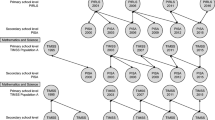Abstract
Disparities in achievement measures that exist between black and white students, commonly referred to as the ‘black-white achievement gap’, are widely discussed in educational literature (Lubienski, 2008). In fact, even before the advent of modern standardized tests, there was an extended analysis of performance gaps on tests between black and white students (e.g. Crowley, 1932; Bali and Alvarez, 2004; Ferguson, 2002; Harris and Herrington, 2006). Much has been written about performance disparities among blacks, whites, and other ethnic minority groups on the mathematical section of standardized tests, such as the Scholastic Aptitude Test (SAT).
Access this chapter
Tax calculation will be finalised at checkout
Purchases are for personal use only
Preview
Unable to display preview. Download preview PDF.
Similar content being viewed by others
Author information
Authors and Affiliations
Editor information
Editors and Affiliations
Rights and permissions
Copyright information
© 2013 Springer-Verlag Berlin Heidelberg
About this chapter
Cite this chapter
Hu, X., Xu, Y.J., Hall, C., Walker, K., Okwumabua, T. (2013). A Potential Technological Solution for Reducing the Achievement Gap Between White And Black Students. In: Falmagne, JC., Albert, D., Doble, C., Eppstein, D., Hu, X. (eds) Knowledge Spaces. Springer, Berlin, Heidelberg. https://doi.org/10.1007/978-3-642-35329-1_5
Download citation
DOI: https://doi.org/10.1007/978-3-642-35329-1_5
Published:
Publisher Name: Springer, Berlin, Heidelberg
Print ISBN: 978-3-642-35328-4
Online ISBN: 978-3-642-35329-1
eBook Packages: Mathematics and StatisticsMathematics and Statistics (R0)




